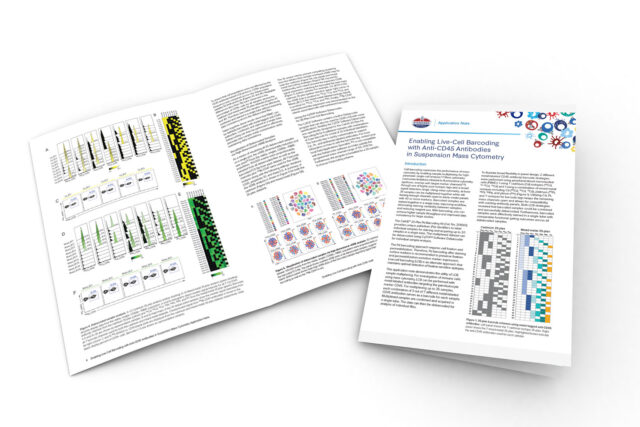Overview
Cell barcoding is a powerful method for multiplexing samples with mass cytometry (CyTOF technology). By staining and acquiring samples in a single tube, barcoding significantly reduces workflow burdens, acquisition times and technical variability, while conserving precious clinical material. In this method, samples are tagged with unique identifiers to enable single-tube staining, reduce staining variability and boost acquisition throughput.
Scalable workflows. Reliable results.
Whether multiplexing fewer than 10 samples or more than 100, barcoding scales experiments and improves data consistency.

Workflow
Individual samples are barcoded with unique metal isotopes for combined staining and acquisition, followed by debarcoding seamlessly integrated within CyTOF Software.

Now available: support for custom debarcoding with CyTOF Software
Improved sample-to-sample staining consistency
Barcoding minimizes sample-to-sample technical variation when multiplexed samples are stained and acquired together.
Data from replicates of the same sample are compared between non-barcoded (no BC) and barcoded (BC) samples.

Applications
CyTOF technology demonstrates barcoding for diverse cell types across a variety of research areas.
A Phase 2 metastatic breast cancer clinical trial
- Unique mass-tag cell barcoding with doublet-filtering scheme
- Paired PBMC samples collected before and after treatment were barcoded, reducing batch effects
126-plex barcoding of organoid samples
- Thiol-reactive tellurium maleimide (TeMal) with cisplatin (Pt) barcoding
- Triplicates from 390 colonic organoid cultures were barcoded in situ
A study of neuroinflammation in an EAE mouse model
- Cell-ID™ palladium (Pd)-based barcoding
- Barcoded samples of mouse spinal cord mononuclear cells were combined in a single tube for a staining and storage
A trial on exercise effects in adults with prediabetes
- Anti-CD45 Pd-based barcodes
- Paired whole blood samples were barcoded and stained together, reducing intra-patient technical sample variability
Baker, C.J. et al. Journal of Diabetes and its Complications (2024)
No CyTOF? No problem!
Our Standard BioTools™ Service Lab can help. Simply ship your samples and get results within 72 hours of sample receipt.

Methods
Choose the right barcoding method that fits your needs.
Novel advancements in barcoding reagents and methods enable researchers who use CyTOF systems to select the ideal barcoding reagent and scheme tailored to their sample type, quantity and cell profiling needs for surface or intracellular targets.

Barcoding Products
Contact SalesCyTOF Software (v9.2.1)
Automated support for a seamless barcoding and analysis workflow
- Debarcoder application optimizes analysis pipeline of multiplexed samples
- Integrated support for custom debarcoding of any isotope combination
- Increased number of barcoding schemes

Product Documents
- CyTOF Debarcoder User Guide →
- Cell-ID 20-Plex Barcoding Kit User Guide →
- Application Note| Enabling Live-Cell Barcoding with Anti-CD45 Antibodies in Suspension Mass Cytometry →
- Application Note | Scale Immunotherapy Clinical Research with Rapid, High-Plex Mass Cytometry (tellurium-based live-cell barcoding) →
- Application Note | The Benefits of Palladium Barcoding on Data Quality and Workflow →
- CyTOF barcoding flyer →
Recent CyTOF barcoding in the literature
Cell-ID 20-Plex Pd Barcoding Kit:
- Lakshmikanth, T. et al. “Immune system adaptation during gender-affirming testosterone treatment.” Nature 633 (2024): 155–164.
- Beerweiler, C.C. et al. “Farm-dust mediated protection of childhood asthma: mass cytometry reveals novel cellular regulation.” Allergy 79 (2024): 3,022–3,035.
CD45 live-cell barcoding:
- Torres, E.T.R. et al. “Etinostat, nivolumab and ipilimumab for women with advanced HER2-negative breast cancer: a phase Ib trial.” Nature Cancer 5 (2024): 866–879.
- Kuratani, A. et al. “Platelet factor 4-induced Th1-Treg polarization suppresses antitumor immunity.” Science 386 (2024): adn8608.
Custom barcoding:



